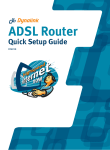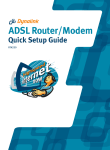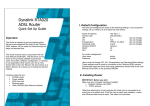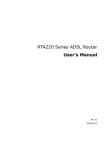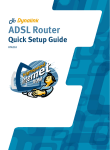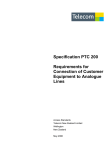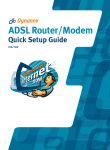Download ADSL Router
Transcript
ADSL Router Quick Setup Guide RTA220 Important This Guide is intended to get you started quickly. The factory default profile of this Router is customised for New Zealand users. Please follow through the steps we describe here to install and set up your Router. This Guide should be read in conjunction with the RTA220 Series ADSL Router User’s Manual. This is provided as a PDF file on the enclosed Driver & Utility CD. For the remainder of this Quick Set Up Guide all references to the Users Manual refer to this PDF file. Note: The User’s Manual was written for international users. New Zealand users should skip most sections of Chapter 3, except PPPoA+NAT mode. PPPoA+NAT is the only connect mode currently supported in New Zealand. Advanced users who have other setup preferences should refer to the User’s Manual. There is a table in Section 8 of this Guide to assist you in locating the relevant material. Important Safety Notes can be found on page III of the User’s Manual. Contents inside this box: RTA220 ADSL Router Power adapter 12VDC 1A ADSL line cord for New Zealand RJ-45 Ethernet cable (straight through cable) USB cable Driver & Utility CDROM (User’s Manual included) If you connect via Ethernet port instead of USB port, there is no driver to load. ADSL Router Quick Set-up Guide 1 Default Configuration for New Zealand This Router is shipped with the following factory default settings. Router IP address Subnet mask VPI VCI Encapsulation NAT DSL line mode WAN IP DHCP UPnP IGD 192.168.1.1 255.255.255.0 0 100 PPPoA VC-MUX enabled auto dynamic enabled disabled Security: Firewall Intrusion Detection off disabled (do not change) (do not change) (do not change) (do not change) Router configuration & management: Administrative User name admin Administrative Password admin Telnet password admin Users must not change the VPI, VCI, Encapsulation or NAT settings. DSL line mode can be set to either auto or G.dmt. Advanced users who have other setup preferences should refer to the User’s Manual. 2 Before you start Make sure your computer has the following installed: An Ethernet or USB port (see ‘Choose your connection option’ below) TCP/IP protocol A web browser, Internet Explorer 5.0/Netscape 6 or better Obtain the following information from your ISP: Login user name and password Public IP address (Note: only required if you purchase a static IP) DNS server IP address (if specified by ISP) Choose your connection option: Ethernet (for a standalone computer) Connect using the enclosed "straight through" Ethernet cable. Ethernet (via a network hub to a LAN) Connect using the enclosed "straight through" Ethernet cable to the UPLINK port of the network hub. If the hub does not have an UPLINK port, connect using a "cross-over" Ethernet cable to any other port of the network hub. Cross-over Ethernet cable is not provided. 3 4 USB (for standalone Windows 98/ME/2000/XP computers) Connecting the Router via Ethernet is the preferred option. However if you decide to connect via the USB port, you must install the USB drivers for this Router. The drivers are found on the enclosed CDROM. Please refer to Chapter 2: Installation on the User’s Manual for step-by-step instructions. Connect the ADSL Router Connect the 12V 1A DC power adapter to the PWR jack of the Router, and plug the adapter into a mains power outlet. Switch on the Router. Connect the DSL port of the Router to your ADSL jackpoint (telephone wall socket) with the enclosed phone line cord. Never connect the ADSL Router through a Microfilter. Connect the LAN port of the Router to the Ethernet port of your computer (or uplink port of a network hub) using the Ethernet cable provided. If you have chosen to connect via the USB port, connect the USB port of the Router to the USB port of your computer (or USB hub) using the USB cable provided. After connecting the cable (LAN or USB), the corresponding light on the front panel of the Router will turn on. If not, it indicates a problem with the Ethernet or USB connection. Refer to Section 10 – Troubleshooting. Configure your computer For a step-by-step guide refer to Chapter 4 - Configuration in the User’s Manual. The description below assumes you are connecting via an Ethernet port. By default the DHCP server on your ADSL Router is enabled. The simplest configuration method is to follow option 1 below. STEP 1 OBTAIN AN IP ADDRESS FROM THE ADSL ROUTER You do not need to specify an IP address when configuring TCP/IP properties. If your computer stands alone and is set up to obtain an IP address automatically, you can move on to Section 5 – Going On-Line. ADSL Router Quick Set-up Guide STEP 2 MANUALLY ASSIGN A FIXED IP ADDRESS TO YOUR COMPUTER If you prefer to assign an IP address manually, use 192.168.1.x (x is any number between 2 and 254) and subnet mask 255.255.255.0. Specify the gateway as 192.168.1.1 and enter DNS server IP as 192.168.1.1. Windows specific instructions follow: Windows 95/98/ME: From Control Panel, double click Network. Scroll down and highlight TCP/IP (your network card). Click Properties. Select the IP Address tab. Enter 192.168.1.x (x is any number between 2 and 254). This is the IP address assigned to your computer. Subnet Mask is 255.255.255.0. Select the Gateway tab. Enter the Router’s IP address 192.168.1.1 and click Add. Click OK & then OK to finish. You may be prompted for the Windows CD and then be asked to restart. Answer Yes to restar t the computer. For Windows 2000/XP: From Control Panel double click Network Connections. Open Local Area Connections and click Properties. Double click Internet Protocol (TCP/IP). Select Use the following IP address. Enter 192.168.1.x (x is any number between 2 and 254). This is the IP address assigned to your computer. Subnet Mask is 255.255.255.0. Enter the Router’s IP 192.168.1.1 as the Default gateway, and Preferred DNS server. Click OK to finish. You have now finished configuring your computer. 5 Going On-line This requires only 3 simple steps. STEP 1 GO TO THE ROUTER’S QUICK START PAGE Start your web browser. Enter the address http://192.168.1.1. Enter user name and password if required to proceed. By default, the username is admin and the password is admin. You will see the Quick Start page of the Router. Refer to Q1 in Section 10 - Troubleshooting if you cannot get this screen. ADSL Router Quick Set-up Guide STEP 2 ENTER INTERNET ACCOUNT DETAILS First check on the front panel of the Router that the DSL light has turned solid indicating the link is up. Click the Connect button. Do not click "Apply & Save" as this button is intended for changing the pre-defined profile. Enter your Internet account User Name & Password. Click Connect. The Router will now connect to your ISP. At any time in the future if you wish to check that the Router is on-line, go to Quick Start. A screen similar to the following image confirms that you are on-line. It shows the public IP address assigned by your ISP, and the time the Router has been on-line. Click Disconnect only if you wish to interrupt the connection. If you cannot get online refer to Q2 in Section 10 - Troubleshooting. STEP 3 SAVING USERNAME & PASSWORD INFORMATION If you want to save your Internet account user name & password into the Router, go to System - Save Configuration in the Router menu. Enter the Router’s administrative user name and password if required to proceed. By default, the Router administrative user name and password are both admin. Click Save. Wait for confirmation. From here the Router’s basic configuration is completed. Note: If you manually assigned a fixed IP address to your computer or you have another DHCP server already on your LAN, disable the DHCP server on your ADSL Router. Refer to LAN Configuration - DHCP server on Page 50 of the User’s Manual. ADSL Router Quick Set-up Guide 6 Important tips for security In order to benefit from the security features of this Router; Do: Change your Router’s administrative user name & password Enable firewall security on the Router Back up your Router’s configuration Don’t: Enable remote access to the Router unless you know how to handle security Send your Router away for repair or replacement without resetting to factory default or wiping out your Internet account login details To change the Router’s administrative user name & password, go to System – Administrative Security. Select a user name and password you will not forget. Firewall security - It is recommended that the firewall be enabled. There are four preset levels of security: Low, Medium, High & Block. At the "Block" level nothing passes through. Reducing the security level allows more types of traffic to pass through e.g. no ICQ traffic is allowed in or out at security level Medium, however the Router will allow outgoing ICQ traffic at security level Low. To enable the firewall, go to Configuration – Security - Firewall. Select the level of security you require. Click Apply, and save configuration using t h e Sy s t e m - S a ve Configuration menu. Advanced users may want to customise the default firewall policies to meet their particular needs. Please refer to page 57 of the User’s Manual. 7 8 Backup the Router configuration It is desirable to keep copies of your configuration on disk. The Router can read from a saved configuration file and restore your customised configuration after events such as a reset to factory defaults. To backup or restore your Router’s configuration, go to System - Quick Configuration. Guide to the Users Manual Refer to these page numbers of the Users Manual on the enclosed CD for: USB DRIVER INSTALLATION Windows 98 Windows 2000 4 8 Windows ME Windows XP 6 10 Windows ME Windows 2000 29 33 Configuring a PC to get an IP address from a DHCP server Windows 98 36 Windows ME Windows NT 37 Windows 2000 Windows XP 38 37 37 CONFIGURATION Setting up TCP/IP on a client PC Windows 98 25 Windows NT 29 Windows XP 35 WEB-BASED ROUTER CONFIGURATION MENU Using Web-Based Manager 41 Quick Start 42 System Device Information Quick Configuration Upgrade Software 43 44 45 Administrative Security Save Configuration Reset Router 43 45 46 Status DSL Connection Traffic Counter DHCP Table 46 47 48 WAN Connection Routing Table 47 47 Configuration DSL Configuration WAN Configuration DNS Virtual Server 49 52 55 61 LAN Configuration IP Route Security UPnP 50 54 57 63 ADSL Router Quick Set-up Guide 9 Indicator lights There are five indicators on the Router’s front panel. Every time the Router is powered on or reset, all the lights will come on indicating the self-test is in progress. Indicator Function Description PWR Power Off - No power. On - Power is on. DIAG Diagnosis Off - Self-test OK. Blinking – System updating. On - Self-test or system failure. LAN Ethernet Link Off - Ethernet link not present. Blinking – Data going through Ethernet port. On - Ethernet link is ok. USB USB Link Off - USB link not present. Blinking - Data going through USB port. On - USB link is ok. DSL Link Status Off - Handshaking/training in progress. Blinking - Data going through ADSL port. On - ADSL link is up. 10 Troubleshooting Q1. Cannot open the Router control panel from my browser. 1. Check that the Router’s LAN (or USB) light is on. If not, check your Ethernet (or USB) cable. If you connect via Ethernet, check that the Ethernet cable we supplied is plugged directly into a stand-alone computer OR the uplink port of network hub. Should the cable be plugged into any other port on a hub, a crossover (or uplink) cable must be used. A crossover cable is not provided with the Router. 2. If you assign IP addresses manually, check that every IP on the LAN is unique. The Router’s private IP is 192.168.1.1 by default. You must use this address, or the address you have changed it to, in order to access the Router’s control panel. If your computer obtains an IP address from the Router, follow this procedure to make sure your computer’s IP address is renewed: Windows 95/98/ME: 1. Go to Start - Run. Type winipcfg in the dialog box and click OK. 2. When the IP configuration screen appears, click Release and then Renew. Windows NT4/2000/XP: 1. Go to Start - Run. Type cmd in the dialog box and click OK. 2. At the command prompt type ipconfig to display IP information from DHCP server. 3. Type ipconfig /release and then type ipconfig /renew. 3. Perform a PING test. Go to Start–Programs–MS DOS or Command Prompt (In WinXP/2000/NT4 click Start-Run. Enter cmd then OK). Type ping 192.168.1.1 then press Enter. Pinging 192.168.1.1 with 32 bytes of data: Reply from 192.168.1.1: bytes=32 time=4ms TTL=30 ... If you see a similar response, the Router is communicating with the network correctly and the problem lies elsewhere. If the result is Request timed out or a similar failure, there is a TCP/IP networking problem. Check the LAN cable type is correct (as in step 1 above) and firmly plugged in. To check a computer's network settings see Step 2 (Section 4 – Configure your computer). 4. Disable any personal firewall or virus checking software temporarily. If you are using Internet Explorer, go to Tools–Internet options-Security. Reset the security level of all 4 icons to default. You can revert to your customised settings after configuring the Router. ADSL Router Quick Set-up Guide 5. If previously you were using a dialup modem, check the browser configuration. For example in Internet Explorer, go to Tools–Internet options–Connections, and select Never dial a connection. Also check LAN Settings that the option Use a Proxy Server is not selected. 6. If the Router is connected to a network hub, try connecting the Router directly to the computer in a standalone setup to eliminate any possible hub problems. 7. If the LAN already has a DHCP server enabled, disable it. Refer to the second paragraph of Section 4 – Configure your computer in the User’s Manual. Q2. Cannot connect to the Internet or cannot browse. 1. Check that Router’s DSL light is on. Normally it takes less than one minute to establish an ADSL link. A link will establish as long as there is sufficient signal. If the DSL light does not come on the Router is not detecting any signal. Check that: • The ADSL service has been enabled • The Router is connected to the correct jackpoint • The Router is connected directly to a jackpoint, not after a filter or other device. 2. Check that Router is on line. Bring up the Quick Start menu of the ADSL Router Control Panel. Refer to Step 2 – Enter Internet account details of Section 5 - Going On-Line. If NAT IP shows 0.0.0.0, you are not on line. Make sure the correct user name and password are entered. The username and password are provided by your ISP. 3. Check the configuration of your computer and Router. If you still cannot browse, perform a PING test as described in Q1-3, using these addresses: (A) Ping www.dynalink.co.nz (or any valid web address) (B) Ping 205.178.180.16 (or any valid public IP address) If both (A) & (B) returned no reply, go to Quick Start and check that NAT is enabled. Also make sure the Router’s firewall is not set to Block. If these settings are correct, ping the computer’s IP address (e.g. ping 192.168.1.2). If there is still no reply your network card may be faulty. If (A) returned no reply but (B) showed a reply, this is probably a DNS problem. Check that you have entered the correct DNS address if this is required by your ISP. If both (A) & (B) showed a reply, it could be a problem with your browser settings. Try returning any custom settings of the browser to default. If you have personal firewall software running, disable it. Check if the condition in Q1-5 applies. Finally shut down the computer and restart it. Q3. Browsing is fine but I cannot run certain applications, such as ICQ. Check that your firewall security setting is not too high. Try temporarily disabling the firewall. If the application now runs, you can either lower the security level setting, or tailor your firewall settings to allow traffic of the application through. Q4. My customised Router administrative password has been forgotten and the Router control panel is no longer accessible. Restore the Router to factory defaults. A hidden reset button is located next to the power on/off button at the back. Using a suitable size pin, while the Router is powered on press the reset button for several seconds and release. All the front panel lights should come on indicating a successful reset. Warranty Dynalink Modems Ltd warrants this product against defects in materials and workmanship for a period of twelve months from the original date of purchase. We will, at our discretion, repair or replace the faulty unit, free of charge, provided it is returned to us with proof of purchase from an authorised dealer within the warranty period. Return delivery after repair will be paid for by Dynalink Modems Ltd within New Zealand. We reserve the right not to repair or replace goods that: have been mishandled, abused or not installed according to the guidelines as outlined in the instructions. have been subjected to a power surge from other equipment or other external factors. have been altered or modified. Help Always check that your hardware is installed correctly. Check our web site for the latest information and troubleshooting guide. If you have difficulties, contact Dynalink Technical Support for issues relating to router installation and operation: Phone: Fax: Email: Web: 0800 653 962 (Mon-Fri, 9am-6pm) 0800 503 962 [email protected] www.dynalink.co.nz NZRTA220QG-01















